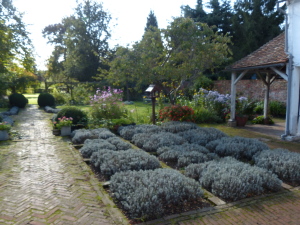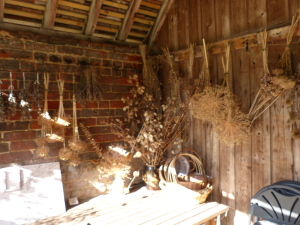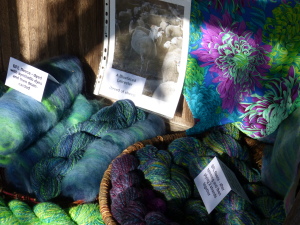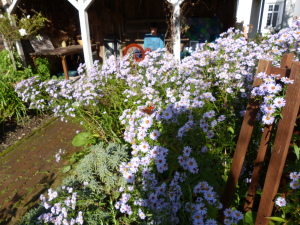You know you’ve gone a bit potty for fiber when you find yourself in a 16th century merchant’s house in Coggeshall, Essex knitting and talking about wool all day.
That’s how I spent last Friday at Paycockes‘, with fellow members of The Mid-Essex Guild of Weavers, Spinners & Dyers’ doing our bit for Wool Week.
Paycockes is a National Trust property nearby me. It’s a classic Tudor-styled building with a gentle garden in the back sloping down toward the River Blackwater. The Guild has demonstrated there before, because Paycockes has come to represent the wealth created by the East Anglian cloth trade. Naturally wool was at the center of that trade. There are many other towns and villages in Essex, Suffolk and Norfolk associated with the wool trade–notably Lavenham, Colchester and Braintree.
These days the accepted wisdom is that wool, and therefore wool fabric, woollen garments, knitting yarn made of wool etc, is in a decline. Hence the Campaign for Wool’s Wool Week events. Basically, it’s a world-wide effort to promote wool as a natural and renewable fiber suitable for a wide range of uses from garments to home insulation. Sounds like a no-brainer, right?
The Mid-Essex Guild’s spin and knit-in was but a small part of the Wool Week activities, but it did give me the chance to chat to and answer questions from Paycockes’ visitors. I’m going to share some of the comments made and see what you think.
“You just don’t see wool anymore.” That was a comment from one woman who came in and spoke to us about knitting for quite awhile. She wondered aloud if wool’s disappearance wasn’t related to “disposable high street fashion and out throw away society”. It’s a theory I guess. I couldn’t get past her first comment about wool just not being around. Really? I thought. But then I’m probably not a good judge of these things.
Another theory about the decline of wool was: “We all have central heating now. We don’t need big woolly sweaters.” That makes sense to me. Paycockes’ visitors also observed, wool might be quite itchy, and moths like to eat it and then there’s the washing or dry cleaning. I hadn’t really considered all these reasons not to wear wool. But then I wouldn’t.
Other people asked me about my circular knitting needles and made comments about the big ball of wool one of the guild members had with her. “My what I big ball of wool!” The other comment that really struck me was this: “You can wear handknits again.” While wool is deemed to be less popular now, knitting is experiencing a resurgence in the UK. I can testify to that. Ten years ago there were two or three places to buy yarn in London, for example, and the range of yarn was limited. Now there are more shops and there is more choice. It’s a big difference.
Still, it didn’t occur to me that there was a problem with handknitted garments. But of course there is or was. There is still this lingering idea that store-bought is better. I also took the statement: “You can wear handknits again.” to mean there’s no longer shame in wearing handknits. It’s OK now. It’s even fashionable. In some quarters, knitting is still considered an activity one does out of thriftiness not for pleasure. Any knitter knows that these days most yarn is not cheap. Larger handknit projects can cost you a fortune in materials. Sal reckons most of the garments in Vogue Knitting require about $200-$300 in yarn. Not cheap!
Today I drove up to Colchester. When you come off the main road and head into town there is a meadow on the left side of the road. Usually there is a herd of cows in there munching away. Today it was full of sheep. Wool on the hoof for all to see.




